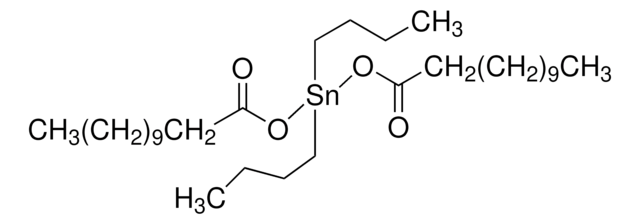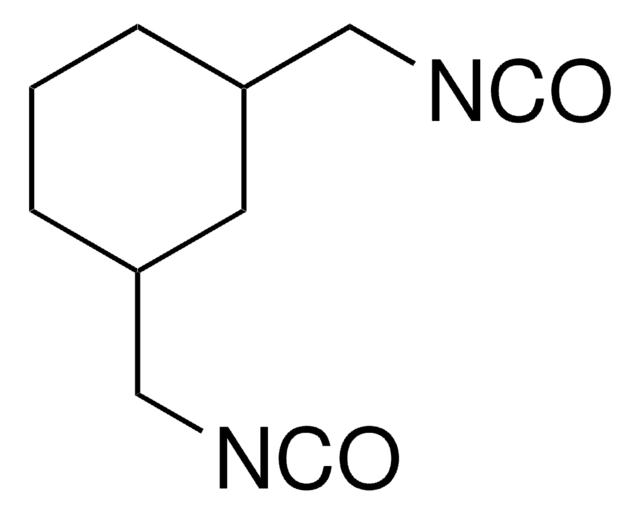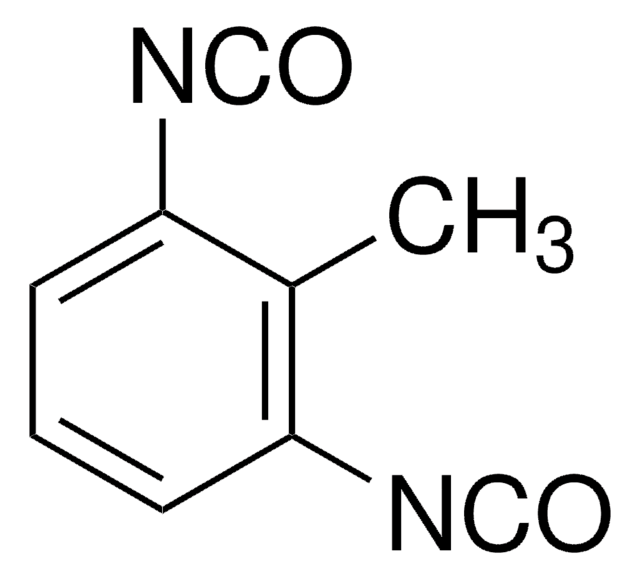317624
Isophorone diisocyanate
98%, mixture of isomers
Synonyme(s) :
5-Isocyanato-1-(isocyanatomethyl)-1,3,3-trimethylcyclohexane
About This Item
Produits recommandés
Niveau de qualité
Pureté
98%
Forme
liquid
Indice de réfraction
n20/D 1.484 (lit.)
Point d'ébullition
158-159 °C/15 mmHg (lit.)
Densité
1.049 g/mL at 25 °C (lit.)
Chaîne SMILES
CC1(C)CC(CC(C)(CN=C=O)C1)N=C=O
InChI
1S/C12H18N2O2/c1-11(2)4-10(14-9-16)5-12(3,6-11)7-13-8-15/h10H,4-7H2,1-3H3
Clé InChI
NIMLQBUJDJZYEJ-UHFFFAOYSA-N
Vous recherchez des produits similaires ? Visite Guide de comparaison des produits
Description générale
Application
- Production of polyurethane coatings for automotive and industrial applications.
- Synthesis of polyurethane elastomers used in medical devices and sports equipment.
- Production of polyurethane foams used in upholstery, insulation, and packaging applications.
- Use in the manufacture of adhesives, sealants, and binders.
- In the synthesis of bridged silsesquioxane(BSQ) by sol-gel polycondensation with 3-aminopropyltriethoxysilane. The polymer of BSQ can be used to prepare the moisture-resistant film for UV filters.
- As a healing agent in the preparation of polyurethane microcapsules by interfacial polymerization.
- As a monomer in the synthesis of highly monodispersed polyurea microspheres via precipitation polymerization.
Mention d'avertissement
Danger
Mentions de danger
Conseils de prudence
Classification des risques
Acute Tox. 1 Inhalation - Aquatic Chronic 2 - Eye Irrit. 2 - Resp. Sens. 1 - Skin Irrit. 2 - Skin Sens. 1 - STOT SE 3
Organes cibles
Respiratory system
Code de la classe de stockage
6.1A - Combustible acute toxic Cat. 1 and 2 / very toxic hazardous materials
Classe de danger pour l'eau (WGK)
WGK 2
Point d'éclair (°F)
325.4 °F - closed cup
Point d'éclair (°C)
163 °C - closed cup
Équipement de protection individuelle
Eyeshields, Faceshields, Gloves, type ABEK (EN14387) respirator filter
Faites votre choix parmi les versions les plus récentes :
Déjà en possession de ce produit ?
Retrouvez la documentation relative aux produits que vous avez récemment achetés dans la Bibliothèque de documents.
Les clients ont également consulté
Protocoles
HPLC Analysis of Isocyanates on Titan™ C18
Notre équipe de scientifiques dispose d'une expérience dans tous les secteurs de la recherche, notamment en sciences de la vie, science des matériaux, synthèse chimique, chromatographie, analyse et dans de nombreux autres domaines..
Contacter notre Service technique












